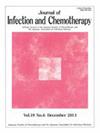Multiple arterial aneurysms in a patient with spondylitis following intravesical Bacillus Calmette-Guérin administration for bladder cancer: A case report
IF 1.9
4区 医学
Q3 INFECTIOUS DISEASES
引用次数: 0
Abstract
Mycobacterium bovis is one of the species belonging to the Mycobacterium tuberculosis complex; its attenuated form—Bacillus Calmette-Guérin (BCG)—is used as a live vaccine against tuberculosis. Besides its use as a vaccine, BCG is widely used for treating bladder cancer. However, complications related to its use can lead to disseminated infection with M. bovis, known as BCGosis. BCGosis has multiple manifestations, and its culture requires a long time and complex polymerase chain reaction (PCR), posing challenges to its diagnosis. Herein, we report a case of a 74-year-old man with bladder cancer in whom multiple new arterial aneurysms developed during spondylitis treatment following intravesical BCG administration. The patient presented with syncope and left neck swelling. His medical history included transurethral bladder tumor resection and intravesical BCG therapy for bladder cancer. Sixteen months before he visited our institution, he developed spondylitis (L5/S1), an epidural abscess (L5/S1), and an abscess on the right thigh. Biopsy cultures and PCR confirmed M. tuberculosis complex, leading to antituberculosis drug therapy. Upon admission, multiple aneurysms were identified, and drug therapy was continued. However, new multiple aneurysms developed with the rupture of the right femoral aneurysm, leading to surgical interventions and arterial biopsy. The biopsy showed no signs of mycobacterial infection. Other aneurysm etiologies were ruled out and M. bovis was confirmed by PCR in the specimen from the initial intervertebral disc biopsy; thus, a diagnosis of BCGosis was made. This case highlights the importance of a thorough follow-up to detect new complications, even during treatment.
膀胱癌鞘内注射卡介苗后脊柱炎患者出现多发性动脉瘤:病例报告。
牛分枝杆菌是结核分枝杆菌复合体中的一种,其减毒形式--卡介苗(BCG)--被用作预防结核病的活疫苗。除了用作疫苗,卡介苗还被广泛用于治疗膀胱癌。然而,与使用卡介苗有关的并发症会导致牛杆菌播散性感染,即卡介苗病。卡介苗病有多种表现形式,其培养需要较长的时间和复杂的聚合酶链反应(PCR),给诊断带来了挑战。在此,我们报告了一例患有膀胱癌的 74 岁男性患者,他在膀胱内注射卡介苗后,在脊柱炎治疗期间出现了多个新的动脉瘤。患者出现晕厥和左颈部肿胀。他的病史包括经尿道膀胱肿瘤切除术和膀胱内卡介苗治疗膀胱癌。在来我院就诊的16个月前,他患上了脊柱炎(L5/S1)、硬膜外脓肿(L5/S1)和右大腿脓肿。活检培养和聚合酶链式反应(PCR)证实了结核杆菌复合体,因此接受了抗结核药物治疗。入院时发现多发性动脉瘤,继续接受药物治疗。然而,随着右股动脉瘤的破裂,又出现了新的多发性动脉瘤,因此需要进行手术干预和动脉活检。活检结果显示没有分枝杆菌感染的迹象。排除了动脉瘤的其他病因,并在最初的椎间盘活检标本中通过 PCR 确认了牛杆菌,因此确诊为卡介苗病。该病例强调了即使在治疗期间也要进行彻底随访以发现新并发症的重要性。
本文章由计算机程序翻译,如有差异,请以英文原文为准。
求助全文
约1分钟内获得全文
求助全文
来源期刊

Journal of Infection and Chemotherapy
INFECTIOUS DISEASES-PHARMACOLOGY & PHARMACY
CiteScore
4.10
自引率
4.50%
发文量
303
审稿时长
47 days
期刊介绍:
The Journal of Infection and Chemotherapy (JIC) — official journal of the Japanese Society of Chemotherapy and The Japanese Association for Infectious Diseases — welcomes original papers, laboratory or clinical, as well as case reports, notes, committee reports, surveillance and guidelines from all parts of the world on all aspects of chemotherapy, covering the pathogenesis, diagnosis, treatment, and control of infection, including treatment with anticancer drugs. Experimental studies on animal models and pharmacokinetics, and reports on epidemiology and clinical trials are particularly welcome.
 求助内容:
求助内容: 应助结果提醒方式:
应助结果提醒方式:


